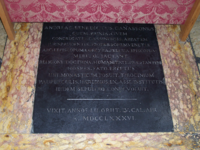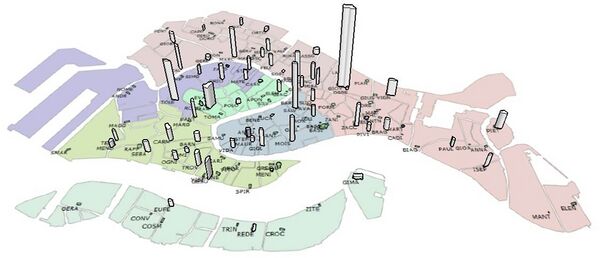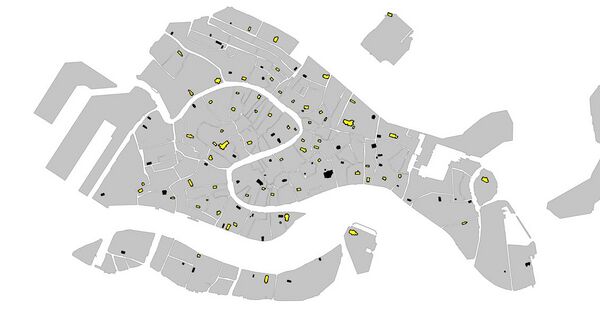Church Floor Artifacts
This article contains information on the Church Floor Artifacts of Venice.
For a list of Churches in Venice, see Churches. For information on a typical artifact, see Church Floor Artifact.
 | |
| Churches with Assessed Artifacts | 74 |
|---|---|
| Total Number of Artifacts | 2221 |
| Number of Tombs | 1724 |
| Number of Plaques | 497 |
A church floor artifact is anything that was inlaid in the floor after construction. Typically, these artifacts contain inscriptions or are a different shape or material than the surrounding floor. Venetian church floor artifacts can be broken down into two categories, tombs and plaques. One of the reasons visitors choose to enter the churches of Venice is to view the artwork they contain. The artwork is not limited to sculptures and paintings displayed at eye level on the walls of building or on podiums in public squares. Many of Venice’s relics are found below eye level, in the floors of churches. Venetians used the materials available to decorate all aspects of their lives, including the ground they walked on. Some of these floor artifacts go unnoticed by visitors because they are overwhelmed by the other sights around them and forget to look at what is below their feet. Overlooking the floors of churches has not only allowed
these pieces to slip out of the minds of visitors, but has also led to neglect in their care and protection.
Churches with Artifacts

This map shows the churches of Venice (not including its lagoon) as bars, where the height of each Church building represents the number of Floor Artifacts that can be found in it. For example, the tallest bar on the graph corresponds to the Church of San Zanipolo (Santi Giovanni e Paolo) in Castello which has 207 Church Floor Artifacts.[1]
Artifact Breakdown

There are two types of artifacts that can be found within the Churches of Venice: Tombs and Plaques. The pie chart seen here shows the division of these. The blue portion of the graph shows the number of Tombs, 1724, while the smaller red part represents the number of plaques in the city, 497. [2]
Map

The map pictured here highlights the Churches of Venice with assessed Church Floor Artifacts.[3]
See Also
For a complete list of Churches in Venice, see Churches.
References
- ↑ Gagnon, Davidm Thompson, Kelly, Ruscitti, Eric. Embedded Heritage: A Study of Venetian Church Floors. An Interactive Qualifying Project for Worcester Polytechnic Institute. 2005.
- ↑ Dechaine, Danielle, Hennessey, Meghan, Orszulak, Jeffrey, Rullmann, Kevin. Treasures Underfoot: Preserving Venice's Church Floor Artifacts. An Interactive Qualifying Project for Worcester Polytechnic Institute. 2012.
- ↑ Dechaine, Danielle, Hennessey, Meghan, Orszulak, Jeffrey, Rullmann, Kevin. Treasures Underfoot: Preserving Venice's Church Floor Artifacts. An Interactive Qualifying Project for Worcester Polytechnic Institute. 2012.
Bibliography
Dechaine, Danielle, Hennessey, Meghan, Orszulak, Jeffrey, Rullmann, Kevin. Treasures Underfoot: Preserving Venice's Church Floor Artifacts. An Interactive Qualifying Project for Worcester Polytechnic Institute. 2012.
S. Hoey, M. Kahan, P Marchetti, K Mazza. Convents, Palaces and Churches: Transformation of Historic Buildings and the Impact on Venice’s Neighborhoods. An Interactive Qualifying Project for Worcester Polytechnic Institute. 2003.
Santos,Luiz G., Petrowski,Craig Peter, Kristant,Elaine Hazel, Delaive,Amanda Leigh. The Church Floors in Venice, Italy -- an Archeological Study and Analysis. An Interactive Qualifying Project for Worcester Polytechnic Institute. 2002.
External Links
None